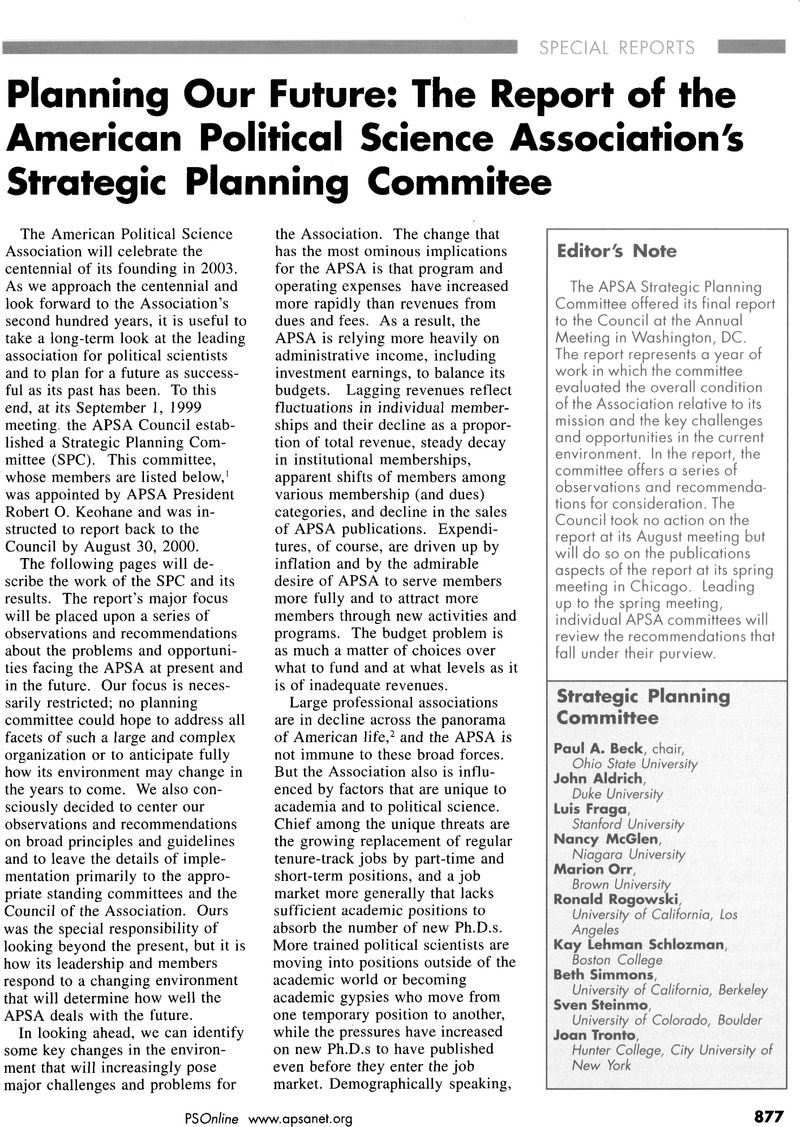No CrossRef data available.
Article contents
Planning Our Future: The Report of the American Political Science Association's Strategic Planning Commitee
Published online by Cambridge University Press: 02 September 2013
Abstract

- Type
- Other
- Information
- Copyright
- Copyright © The American Political Science Association 2000
References
Notes
1. One member originally named to the Committee had to resign before its first meeting due to other responsibilities.
2. On this point, see especially Putnam, Robert, Bowling Alone: The Collapse and Revival of American Community (New York: Simon and Schuster, 2000)Google Scholar.
3. Keohane's, President statement on “APSA's New Strategic Planning Committee” appears in PS: Political Science and Politics, 32 (December, 1999), pp. 783–84Google Scholar.
4. Executive Rudder's, Director statement appears in PS: Political Science and Politics, 32 (December 1999), pp. 784–91Google Scholar.
5. The Committee's report was presented to the APSA Council on September 1, 1993, and appears in the Council's agenda book for that meeting, but it was not published.
6. The Committee's report appears in PS: Political Science and Politics, 24 (March, 1991), pp. 48–59 Google Scholar.
7. See Section 1, Article II of the Constitution of the American Political Science Association.
8. In preparing our proposed mission statement and objectives, we were guided by the valuable statement of organizational mission and objectives prepared by Executive Director Rudder and published as an appendix to her “Draft Design for the Strategic Planning Process,” PS: Political Science and Politics, 32 (December, 1999), pp. 788–89Google Scholar.
9. This results not only from steeply rising costs of audiovisual presentations, instituting poster sessions, and electronic services, but also from our increasing size. The meeting can only be accommodated by using multiple hotels, increasing the number of support services and temporary staff needed to cover multiple sites. Further growth will necessitate the use of costly convention centers.
10. These membership trends are nicely displayed in the July 13, 2000, Executive Director's Report, which has been posted on the APSA web site (www.apsanet.org/PS/sept00/rudder.cfm).
11. Valuable information on income and expenditures also appears in Executive Director Catherine E. Rudder's July 13, 2000 report.
12. APSA's ratio of staff outlays to total outlays is identical to that for the AEA, while the extremes are posted by the American Anthropological Association (where staff compensation is 53% of total outlays) and the American Statistical Association (36%).
13. Two positions are currently half time; hence 24 staffers constitute 23 FTE.
14. Staff members self-report their activity quarterly, and these accounts form the basis for assigning dollar costs to staff activities in various realms.
15. Calculated from memorandum of Laura Tyson to the SPC, May 18, 2000.
16. Virtually all members, and certainly all who have served as section chairs, would regard that change as wise; yet, it required the addition of one new staff FTE. Interview with Laura Tyson, late May.
17. The use of transparencies has become more or less standard, and APSA should expect to subsidize them fully. But higher tech presentations often are very costly, especially where hotels are not equipped to provide them economically. It is questionable whether the Association should underwrite them entirely and, consequently, make them appear to be costless to the user.
18. This recommendation appears on page 8 of the Committee's September 1, 1993 report.
19. For example, proportionally more women, more African Americans, and more Latina/os have served on the APSA Council, its standing committees, and its most recent program committees, respectively, than were members of the Association in early 2000.




